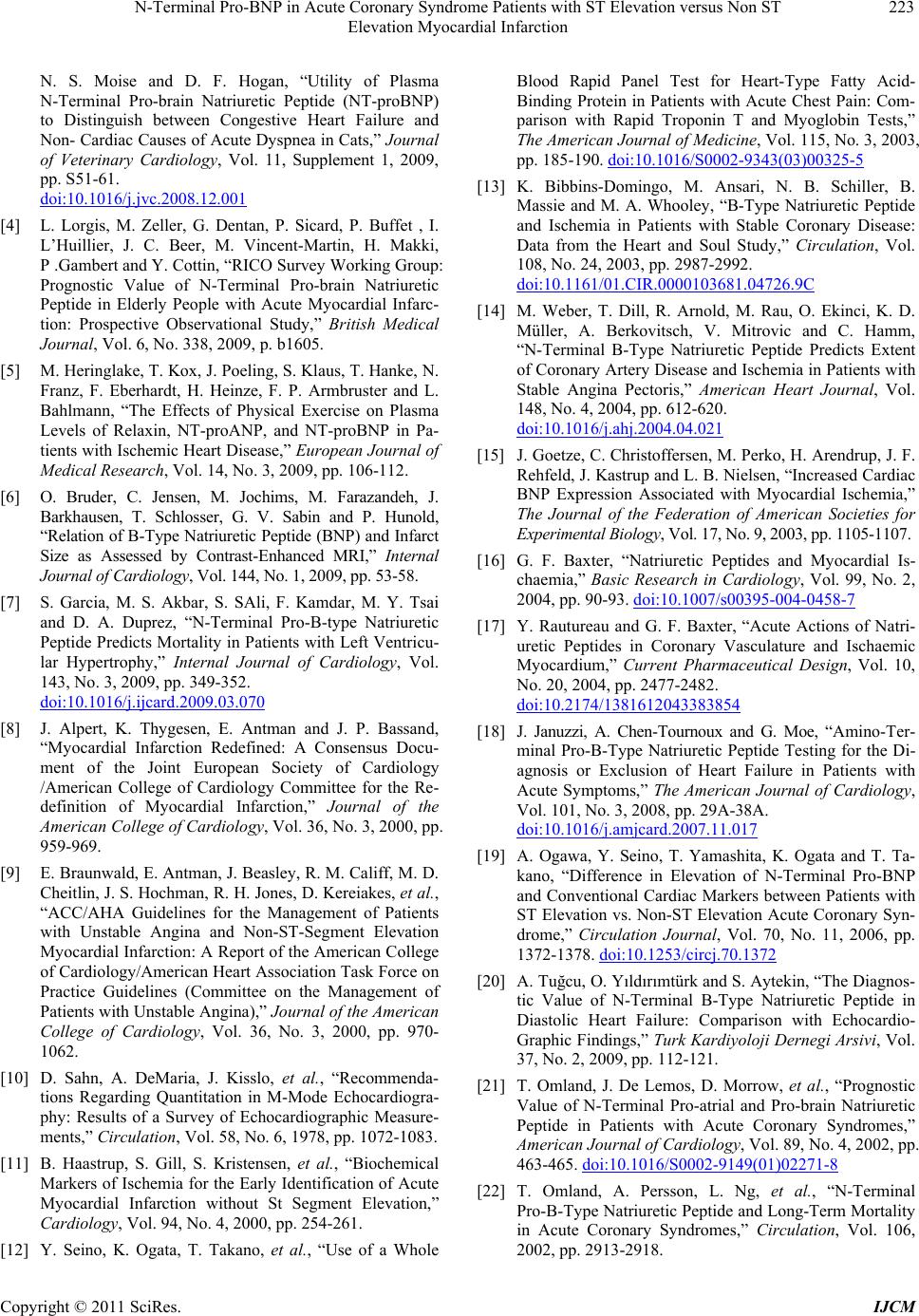
N-Terminal Pro-BNP in Acute Coronary Syndrome Patients with ST Elevation versus Non ST
Elevation Myocardial Infarction
Copyright © 2011 SciRes. IJCM
223
N. S. Moise and D. F. Hogan, “Utility of Plasma
N-Terminal Pro-brain Natriuretic Peptide (NT-proBNP)
to Distinguish between Congestive Heart Failure and
Non- Cardiac Causes of Acute Dyspnea in Cats,” Journal
of Veterinary Cardiology, Vol. 11, Supplement 1, 2009,
pp. S51-61.
doi:10.1016/j.jvc.2008.12.001
[4] L. Lorgis, M. Zeller, G. Dentan, P. Sicard, P. Buffet , I.
L’Huillier, J. C. Beer, M. Vincent-Martin, H. Makki,
P .Gambert and Y. Cottin, “RICO Survey Working Group:
Prognostic Value of N-Terminal Pro-brain Natriuretic
Peptide in Elderly People with Acute Myocardial Infarc-
tion: Prospective Observational Study,” British Medical
Journal, Vol. 6, No. 338, 2009, p. b1605.
[5] M. Heringlake, T. Kox, J. Poeling, S. Klaus, T. Hanke, N.
Franz, F. Eberhardt, H. Heinze, F. P. Armbruster and L.
Bahlmann, “The Effects of Physical Exercise on Plasma
Levels of Relaxin, NT-proANP, and NT-proBNP in Pa-
tients with Ischemic Heart Disease,” European Journal of
Medical Research, Vol. 14, No. 3, 2009, pp. 106-112.
[6] O. Bruder, C. Jensen, M. Jochims, M. Farazandeh, J.
Barkhausen, T. Schlosser, G. V. Sabin and P. Hunold,
“Relation of B-Type Natriuretic Peptide (BNP) and Infarct
Size as Assessed by Contrast-Enhanced MRI,” Internal
Journal of Cardiology, Vol. 144, No. 1, 2009, pp. 53-58.
[7] S. Garcia, M. S. Akbar, S. SAli, F. Kamdar, M. Y. Tsai
and D. A. Duprez, “N-Terminal Pro-B-type Natriuretic
Peptide Predicts Mortality in Patients with Left Ventricu-
lar Hypertrophy,” Internal Journal of Cardiology, Vol.
143, No. 3, 2009, pp. 349-352.
doi:10.1016/j.ijcard.2009.03.070
[8] J. Alpert, K. Thygesen, E. Antman and J. P. Bassand,
“Myocardial Infarction Redefined: A Consensus Docu-
ment of the Joint European Society of Cardiology
/American College of Cardiology Committee for the Re-
definition of Myocardial Infarction,” Journal of the
American College of Cardiology, Vol. 36, No. 3, 2000, pp.
959-969.
[9] E. Braunwald, E. Antman, J. Beasley, R. M. Califf, M. D.
Cheitlin, J. S. Hochman, R. H. Jones, D. Kereiakes, et al.,
“ACC/AHA Guidelines for the Management of Patients
with Unstable Angina and Non-ST-Segment Elevation
Myocardial Infarction: A Report of the American College
of Cardiology/American Heart Association Task Force on
Practice Guidelines (Committee on the Management of
Patients with Unstable Angina),” Journal of the American
College of Cardiology, Vol. 36, No. 3, 2000, pp. 970-
1062.
[10] D. Sahn, A. DeMaria, J. Kisslo, et al., “Recommenda-
tions Regarding Quantitation in M-Mode Echocardiogra-
phy: Results of a Survey of Echocardiographic Measure-
ments,” Circulation, Vol. 58, No. 6, 1978, pp. 1072-1083.
[11] B. Haastrup, S. Gill, S. Kristensen, et al., “Biochemical
Markers of Ischemia for the Early Identification of Acute
Myocardial Infarction without St Segment Elevation,”
Cardiology, Vol. 94, No. 4, 2000, pp. 254-261.
[12] Y. Seino, K. Ogata, T. Takano, et al., “Use of a Whole
Blood Rapid Panel Test for Heart-Type Fatty Acid-
Binding Protein in Patients with Acute Chest Pain: Com-
parison with Rapid Troponin T and Myoglobin Tests,”
The American Journal of Medicine, Vol. 115, No. 3, 2003,
pp. 185-190. doi:10.1016/S0002-9343(03)00325-5
[13] K. Bibbins-Domingo, M. Ansari, N. B. Schiller, B.
Massie and M. A. Whooley, “B-Type Natriuretic Peptide
and Ischemia in Patients with Stable Coronary Disease:
Data from the Heart and Soul Study,” Circulation, Vol.
108, No. 24, 2003, pp. 2987-2992.
doi:10.1161/01.CIR.0000103681.04726.9C
[14] M. Weber, T. Dill, R. Arnold, M. Rau, O. Ekinci, K. D.
Müller, A. Berkovitsch, V. Mitrovic and C. Hamm,
“N-Terminal B-Type Natriuretic Peptide Predicts Extent
of Coronary Artery Disease and Ischemia in Patients with
Stable Angina Pectoris,” American Heart Journal, Vol.
148, No. 4, 2004, pp. 612-620.
doi:10.1016/j.ahj.2004.04.021
[15] J. Goetze, C. Christoffersen, M. Perko, H. Arendrup, J. F.
Rehfeld, J. Kastrup and L. B. Nielsen, “Increased Cardiac
BNP Expression Associated with Myocardial Ischemia,”
The Journal of the Federation of American Societies for
Experimental Biology, Vol. 17, No. 9, 2003, pp. 1105-1107.
[16] G. F. Baxter, “Natriuretic Peptides and Myocardial Is-
chaemia,” Basic Research in Cardiology, Vol. 99, No. 2,
2004, pp. 90-93. doi:10.1007/s00395-004-0458-7
[17] Y. Rautureau and G. F. Baxter, “Acute Actions of Natri-
uretic Peptides in Coronary Vasculature and Ischaemic
Myocardium,” Current Pharmaceutical Design, Vol. 10,
No. 20, 2004, pp. 2477-2482.
doi:10.2174/1381612043383854
[18] J. Januzzi, A. Chen-Tournoux and G. Moe, “Amino-Ter-
minal Pro-B-Type Natriuretic Peptide Testing for the Di-
agnosis or Exclusion of Heart Failure in Patients with
Acute Symptoms,” The American Journal of Cardiology,
Vol. 101, No. 3, 2008, pp. 29A-38A.
doi:10.1016/j.amjcard.2007.11.017
[19] A. Ogawa, Y. Seino, T. Yamashita, K. Ogata and T. Ta-
kano, “Difference in Elevation of N-Terminal Pro-BNP
and Conventional Cardiac Markers between Patients with
ST Elevation vs. Non-ST Elevation Acute Coronary Syn-
drome,” Circulation Journal, Vol. 70, No. 11, 2006, pp.
1372-1378. doi:10.1253/circj.70.1372
[20] A. Tuğcu, O. Yıldırımtürk and S. Aytekin, “The Diagnos-
tic Value of N-Terminal B-Type Natriuretic Peptide in
Diastolic Heart Failure: Comparison with Echocardio-
Graphic Findings,” Turk Kardiyoloji Dernegi Arsivi, Vol.
37, No. 2, 2009, pp. 112-121.
[21] T. Omland, J. De Lemos, D. Morrow, et al., “Prognostic
Value of N-Terminal Pro-atrial and Pro-brain Natriuretic
Peptide in Patients with Acute Coronary Syndromes,”
American Journal of Cardiology, Vol. 89, No. 4, 2002, pp.
463-465. doi:10.1016/S0002-9149(01)02271-8
[22] T. Omland, A. Persson, L. Ng, et al., “N-Terminal
Pro-B-Type Natriuretic Peptide and Long-Term Mortality
in Acute Coronary Syndromes,” Circulation, Vol. 106,
2002, pp. 2913-2918.